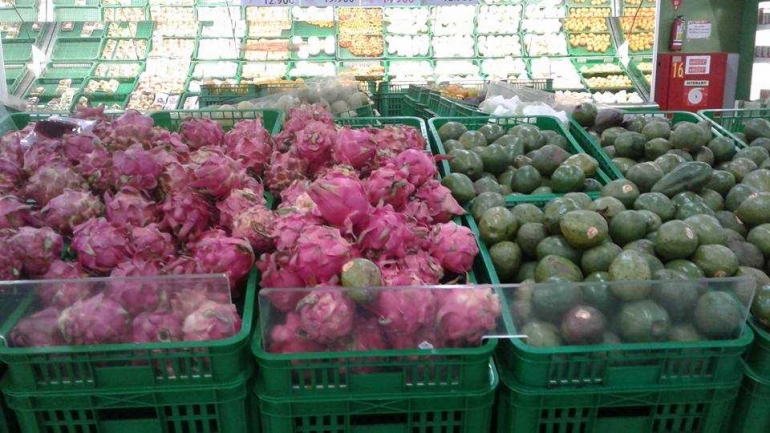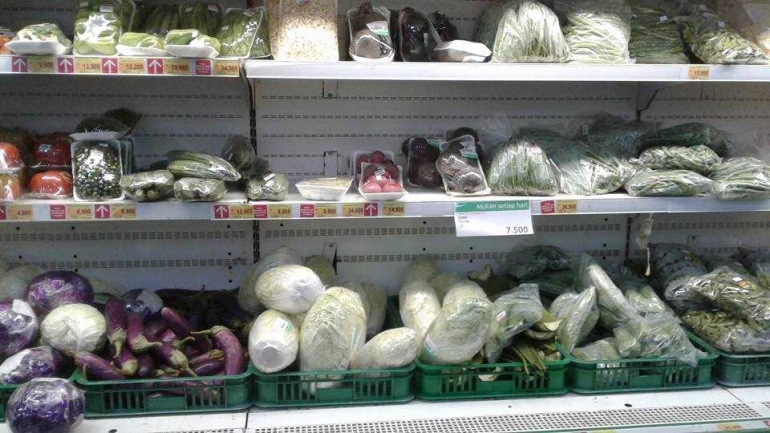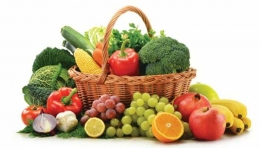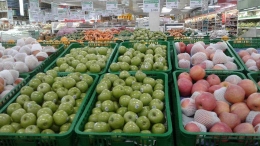Indonesia is an agrarian country and the eight largest producer of fruits and vegetables. However, most Indonesian still do not consume enough of these two food groups in their daily diet. A common view is that One should eat to only feel full and delicious. So, most people do not even care if they consume starch based junk food, high in calories with little to null nutritional value. This of course undermines fruit and vegetables purpose and promote into their daily menus.
In fact according to the 2013 data from the Department of Agriculture, on average each Indonesian consumes only 34.55 kg fruits and 40.35 kg vegetables annually. Meanwhile Food and Agriculture Organization (FAO) has recommended that each individual consumes 73 kg of fruits and 91.25 kg of vegetables every year.
Diseases Related to Lack of Nutrition
Based on WHO/FAO standard, the minimum recommended intake of fruits and vegetables is 400 grams per capita per day. Yet, most of the population are not meeting this requirement. For this reason we need to pay more attention to what we eat and whether it is sufficient to maintain our health.
Low fruits and vegetables intake is a main contributor to micro nutrient deficiencies in many developing world. Inadequate intake is also recognized as one of the key risk factors for cardiovascular diseases and some form of cancers.
Growing economy has also changed people’s life style. Global tight competition has made people busier. As a result it is increasing their likelihood to consume unhealthy food with unbalanced nutrition. They frequent have fast-food consumption at most of the fast food restaurant chains with lack of fruits and vegetables intake. As we all know that fast food generally has a high-energy density, which together with large portion sizes, induces over consumption of calories.
A number of observational studies have assessed the association between frequent fast-food intake and weight gain. The American population study by Cardia suggests that frequent fast-food consumption is positively associated with weight gain and risk of insulin resistance that caused of developing type 2 diabetes and coronary artery disease.
As a result obesity is often appearing on the rise in the society. This eventually has caused an increasing trend of non-communicable diseases, such as heart disorder, kidney failure, liver malfunction, high cholesterols, diabetes, etc.
This is happening in Indonesia too. There are two types of malnutrition; malnutrition that is caused by poverty, while the other is caused by consuming high calories that tend to obese. Currently Indonesia is facing both types of malnutrition as Jansen Ongko, Msc, RD, a nutrition consultant and fitness educator, mentioned during his interview with myself.

Another type of malnutrition that happens in Indonesia is malnutrition. A main factor is poverty. That is for the people who are less fortunate, so they are unable to afford the fruit and vegetables in their daily diet. As a result they eat only to feel full with high calories and little nutritional value that can contribute to stunting.
Why are Fruit and Vegetables Vital?
Fruits and vegetables have many health benefits including antioxidants, fiber, vitamins and minerals. And the good thing is all maintaining a low-calorie status.
In here fiber helps people feel fuller longer thereby assisting with weight management. Research has also shown that fiber helps reduce the risk of heart disease and a variety of cancers. In addition fiber plays a role in diabetes management by stabilizing blood glucose levels. Therefore, high-fiber diet keeps our digestive tract running smoothly and helps to prevent constipation.
So, a good diet should be nutritious, balanced, and varied. For this reason, we need to consume more food groups, but each in moderation.


Failure to accomplish one or more of the segments will jeopardize the whole system, which is to improve health condition of the population. The whole system will require to have appropriate actions by different institutions. Such as in various government ministries, private sector, schools and parents. Coordination and synchronization of such actions are of very important.

Children require healthy diets to support optimal growth and development of their minds and bodies. Healthy eating, including eating a variety of vegetables and fruits helps prevent widespread health problems, such as high blood pressure, high cholesterol, obesity, iron deficiencies, osteoporosis and dental caries.
Moreover nutrition is important for children's development and long-term health. Eating fruit and vegetables can be a habit and promoting healthy eating behaviors for later life. Hence, one of the best ways to encourage children to eat fruit and vegetables is at an early age. So, we need to get our kids interested in and exposed to all different foods with an emphasis on fruit and vegetables.
However, parents are often up against many influences on their child’s food intake. There are the alluring television commercials for junk foods, fancy food packaging for processed foods, the noteworthy influence of peer pressure and the vast availability of “less wholesome” foods at the cafeterias.
Finally, parents can also create positive associations and eating environments to demonstrate how healthy foods are enjoyable and appealing. This will support children in developing a genuine liking and make good food choices as they grow. “Remember to never force our child into eating fruit and vegetables,”as Jansen suggested. It will creates negative impact that could be detrimental and long-lasting memories.
I am fortunate enough for having a 20 year old son who understands the importance in maintaining a well balanced diet. I know it’s not the same for everyone and there’s still a chance that it will change in my house. That is the reason I am always looking for new ways to encourage my son to eat more produce. And the best thing is both of us, my son and I are aware of the importance of eating a variety of fruits and vegetables. It is as part of our healthy eating.
Tips to Get Kids Eating Fruit and Vegetables
1. Be a Role Model
Children have a natural tendency to imitate, so be sure to provide a good example of healthy eating! If you want your child to have a piece of fruit for a snack, parents should do the same. And if you are eating vegetables at dinner, your child is likely to take notice and do the same.

2. Eat Together as a Family:
Having a daily routine where children are served meals at specific time intervals creates expectation which improves appetite. Not to mention, eating together in a relaxed environment generates positive associations and allows children to be exposed to a variety of foods. And breakfast is the most important meal of the day.
3. Ask your Child’s Opinion
Children enjoy brainstorming meal ideas and selecting foods to go in their lunch. Give your child a couple of healthy options to choose from to guide their food choices.
4. Make it fun!
Kids love having fun and this creates a positive association with healthy eating too. Try making fruit using a skewer where your child can select their own fruit pieces. Our child can make a food collage with veggies before eating their creation.
5. Dip it!
Children also enjoy dips which increases vegetable consumption. Try including vegetable dip or hummus along with vegetables as part of lunch. Parents may be surprised how many vegetables they eat!

6. Get Children in the Kitchen!
Go grocery shopping with our children, get them to help in writing a list or encourage them to choose a new fruit or vegetable to try. When at home, delegate specific kitchen tasks to involve our child in the meal preparation. Here we are building a life-skill so be patient and encouraging! Cooking skills are associated with healthy eating since our child will be less reliant on packaged, processed foods.
7. Make our own Smoothies:
Try fruit smoothies for a quick healthy breakfast or afternoon snack. Children can choose which fruits to include and a protein source.
8. Experiment adding Vegetables and Fruits:
Get creative together and try adding vegetables and fruits to baked goods, meal items or salads in variety, because each offers different benefits. Children can enjoy adding fruits to salads or vegetables to omelets or home-made pizzas. One rule of thumb is to “eat the rainbow,” or try to eat fruits and vegetables of different colors.

9. Make it convenient!
Keep lots of fresh fruit and vegetable washed and available for quick snacks. Also we could add to lunches or to include in our meals. Keep these foods available and visible to promote consumption. Apples, pears, bananas, grapes, carrot and celery sticks are all easy grab on the go. Remember to add yogurt, nut butter, or hummus for extra protein.
10. Persevere!
Don’t give up on providing healthy options, even if your child doesn’t eat them as often. They will be likely to develop a taste as they grow so continue to offer at every meal as well as healthy snack options. Children can also have treats as well.


















